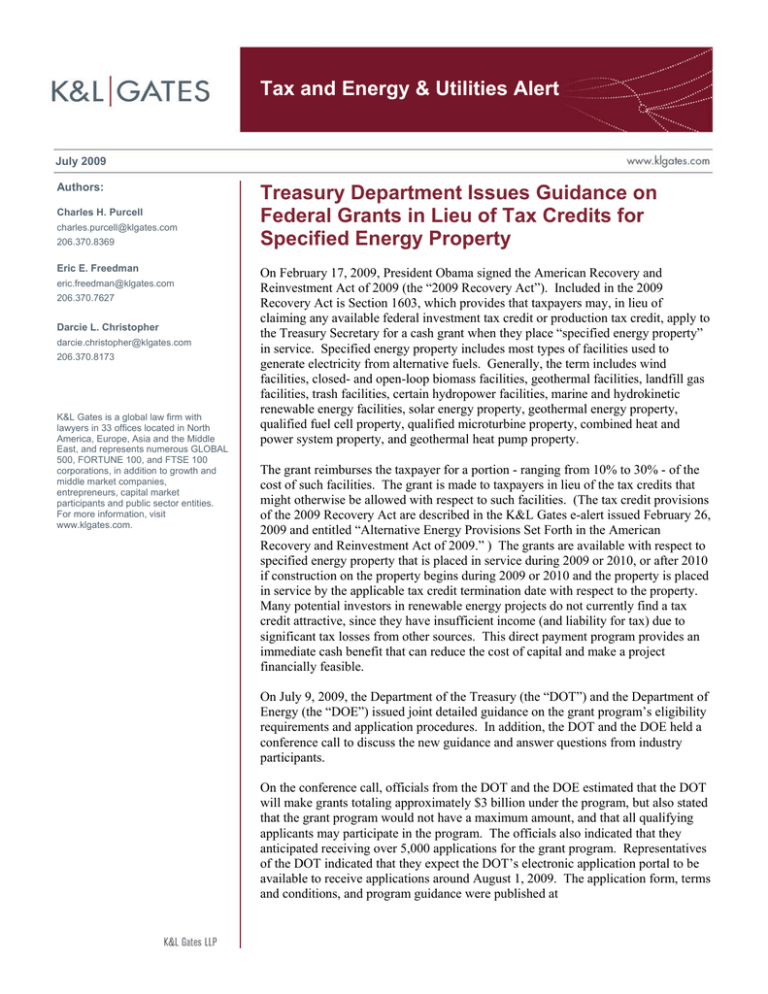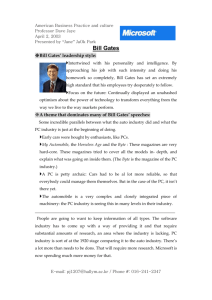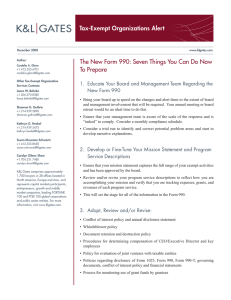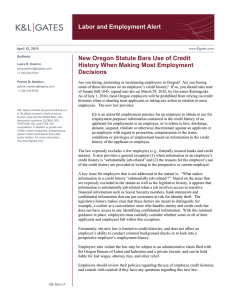
Tax and Energy & Utilities Alert
July 2009
Authors:
Charles H. Purcell
charles.purcell@klgates.com
206.370.8369
Eric E. Freedman
eric.freedman@klgates.com
206.370.7627
Darcie L. Christopher
darcie.christopher@klgates.com
206.370.8173
K&L Gates is a global law firm with
lawyers in 33 offices located in North
America, Europe, Asia and the Middle
East, and represents numerous GLOBAL
500, FORTUNE 100, and FTSE 100
corporations, in addition to growth and
middle market companies,
entrepreneurs, capital market
participants and public sector entities.
For more information, visit
www.klgates.com.
Treasury Department Issues Guidance on
Federal Grants in Lieu of Tax Credits for
Specified Energy Property
On February 17, 2009, President Obama signed the American Recovery and
Reinvestment Act of 2009 (the “2009 Recovery Act”). Included in the 2009
Recovery Act is Section 1603, which provides that taxpayers may, in lieu of
claiming any available federal investment tax credit or production tax credit, apply to
the Treasury Secretary for a cash grant when they place “specified energy property”
in service. Specified energy property includes most types of facilities used to
generate electricity from alternative fuels. Generally, the term includes wind
facilities, closed- and open-loop biomass facilities, geothermal facilities, landfill gas
facilities, trash facilities, certain hydropower facilities, marine and hydrokinetic
renewable energy facilities, solar energy property, geothermal energy property,
qualified fuel cell property, qualified microturbine property, combined heat and
power system property, and geothermal heat pump property.
The grant reimburses the taxpayer for a portion - ranging from 10% to 30% - of the
cost of such facilities. The grant is made to taxpayers in lieu of the tax credits that
might otherwise be allowed with respect to such facilities. (The tax credit provisions
of the 2009 Recovery Act are described in the K&L Gates e-alert issued February 26,
2009 and entitled “Alternative Energy Provisions Set Forth in the American
Recovery and Reinvestment Act of 2009.” ) The grants are available with respect to
specified energy property that is placed in service during 2009 or 2010, or after 2010
if construction on the property begins during 2009 or 2010 and the property is placed
in service by the applicable tax credit termination date with respect to the property.
Many potential investors in renewable energy projects do not currently find a tax
credit attractive, since they have insufficient income (and liability for tax) due to
significant tax losses from other sources. This direct payment program provides an
immediate cash benefit that can reduce the cost of capital and make a project
financially feasible.
On July 9, 2009, the Department of the Treasury (the “DOT”) and the Department of
Energy (the “DOE”) issued joint detailed guidance on the grant program’s eligibility
requirements and application procedures. In addition, the DOT and the DOE held a
conference call to discuss the new guidance and answer questions from industry
participants.
On the conference call, officials from the DOT and the DOE estimated that the DOT
will make grants totaling approximately $3 billion under the program, but also stated
that the grant program would not have a maximum amount, and that all qualifying
applicants may participate in the program. The officials also indicated that they
anticipated receiving over 5,000 applications for the grant program. Representatives
of the DOT indicated that they expect the DOT’s electronic application portal to be
available to receive applications around August 1, 2009. The application form, terms
and conditions, and program guidance were published at
Tax and Energy & Utilities Alert
http://www.treas.gov/recovery/1603.shtml so that
businesses can prepare applications in advance of
the electronic application portal’s launch.
during the construction of the facility, so as to
ensure that the grant is received as expeditiously as
possible.
Applications may not be submitted until the facility
is under construction (for this purpose, the facility
may not be deemed to be under construction unless
more than 5% of the total cost of the property has
been incurred by the taxpayer). The officials also
stated that the grant approval process would involve
personnel of both the DOT and the DOE and would
involve both technical and financing experts,
although the process does not appear to be finalized
at this point.
K&L Gates will provide a more detailed discussion
of the new guidance from the DOT and the DOE on
the grant program early next week.
IRS Circular 230 Disclosure: To ensure compliance with
requirements imposed by the IRS, we inform you that any U.S.
federal tax advice contained in this communication (including any
attachments) is not intended or written to be used, and cannot be
used, for the purpose of (i) avoiding penalties under the Internal
Revenue Code or (ii) promoting, marketing, or recommending to
another party any transaction or matter addressed herein.
Under the terms of Section 1603, the grant must be
issued by the DOT within 60 days after the later of
either the date that the specified energy property is
placed in service or the date that the application is
received. Thus, it would appear that it would be
advisable for taxpayers acquiring or building
specified energy property to submit the application
Anchorage Austin Beijing Berlin Boston Charlotte Chicago Dallas Dubai Fort Worth Frankfurt Harrisburg Hong Kong London
Los Angeles Miami Newark New York Orange County Palo Alto Paris Pittsburgh Portland Raleigh Research Triangle Park
San Diego San Francisco Seattle Shanghai Singapore Spokane/Coeur d’Alene Taipei Washington, D.C.
K&L Gates is a global law firm with lawyers in 33 offices located in North America, Europe, Asia and the Middle East, and represents numerous
GLOBAL 500, FORTUNE 100, and FTSE 100 corporations, in addition to growth and middle market companies, entrepreneurs, capital market
participants and public sector entities. For more information, visit www.klgates.com.
K&L Gates comprises multiple affiliated partnerships: a limited liability partnership with the full name K&L Gates LLP qualified in Delaware and
maintaining offices throughout the U.S., in Berlin and Frankfurt, Germany, in Beijing (K&L Gates LLP Beijing Representative Office), in Dubai,
U.A.E., in Shanghai (K&L Gates LLP Shanghai Representative Office), and in Singapore (K&L Gates LLP Singapore Representative Office); a
limited liability partnership (also named K&L Gates LLP) incorporated in England and maintaining offices in London and Paris; a Taiwan general
partnership (K&L Gates) maintaining an office in Taipei; and a Hong Kong general partnership (K&L Gates, Solicitors) maintaining an office in Hong
Kong. K&L Gates maintains appropriate registrations in the jurisdictions in which its offices are located. A list of the partners in each entity is
available for inspection at any K&L Gates office.
This publication is for informational purposes and does not contain or convey legal advice. The information herein should not be used or relied upon
in regard to any particular facts or circumstances without first consulting a lawyer.
©2009 K&L Gates LLP. All Rights Reserved.
July 2009
2







